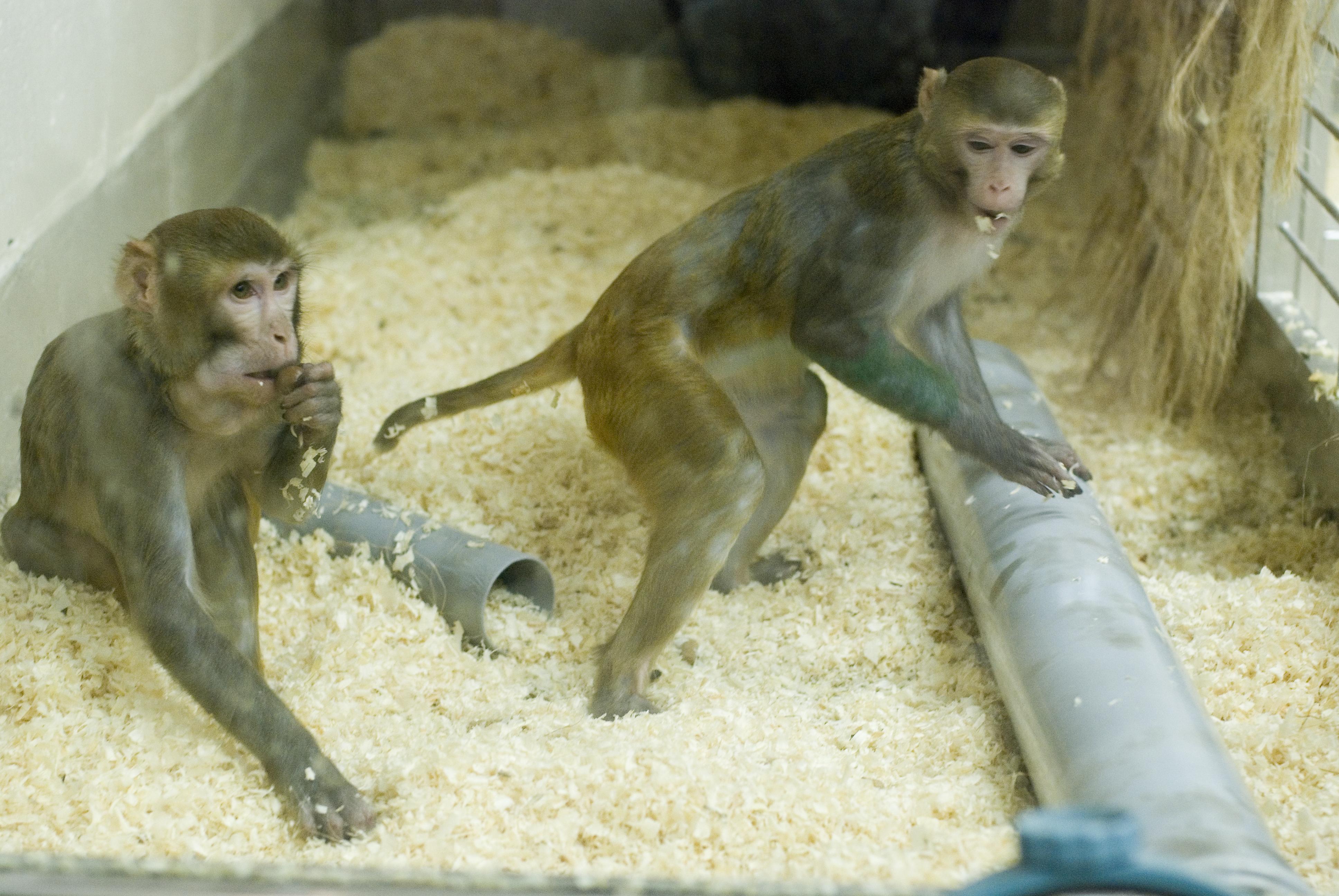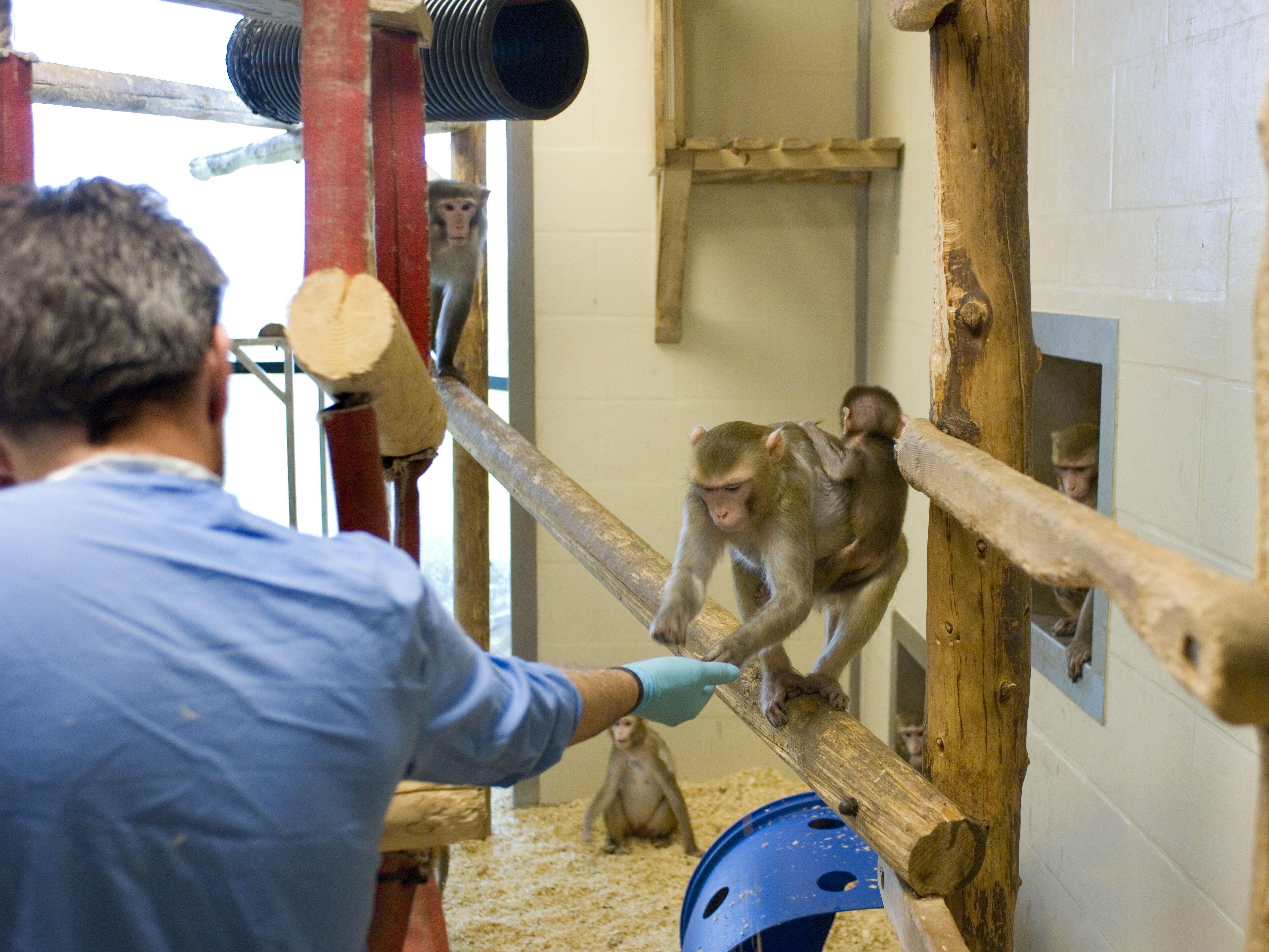Other than overt physical clinical signs, ‘behaviour’ is the most readily accessible and commonly used index for assessing an individual animal’s welfare, but perhaps the easiest to misinterpret without contextual and specialist knowledge. In order to use behaviour as an indicator of animal welfare, normal behavioural patterns for the species and the individual need to be defined first as a reference point. Animals can then be monitored for any changes in behaviour.
Relatively few clear behavioural indicators of good (positive) welfare in the laboratory have been evaluated. Generally, macaques with good welfare will appear relaxed, even if there are social tensions related to bids for dominance. They will spend much time grooming, resting in body contact and foraging, and the group as a whole will not appear tense or nervous. See the Behaviour section for more information on normal behaviour for macaques.
Examples of behaviours in each category are:
A restricted behavioural repertoire
-
Failure to make full use of the environment.
-
Cessation of foraging or locomotion.
-
Little curiosity towards novel objects.
-
Little or no vocalisation.
An abnormal time budget
-
Restlessness or hyperactivity (e.g. circling).
-
Decreased activity (lethargy).
-
General inactivity or unresponsiveness.
-
Excessive eating (hyperphagia).
-
Psychogenic excessive water drinking (polydypsia).
Inappropriate social behaviour
-
Increased aggression to conspecifics.
-
Excessive fear towards or withdrawal from conspecifics (e.g. hiding at the back of the enclosure, hiding within or behind enclosure furniture).
-
Over grooming or hair plucking of conspecifics leading to hair loss.
-
Failure to mate.
-
Killing or neglect of young.
-
Change in behaviour towards human handlers (e.g. increased aggression or withdrawal).
-
Change in the behaviour of cage-mates towards the individual animal.
Other abnormal behavioural patterns
-
Postural stereotypy (e.g. saluting/floating limb, head tossing and rocking).
-
Locomotor stereotypy (e.g. excessive pacing, weaving, circling and somersaulting).
-
Self harm behaviours (e.g. biting, eye poking, hair plucking).
-
Urine drinking.
-
Consumption of faeces (coprophagy).
-
Teeth clenching or grinding (bruxism).
Retreat to the back, upper portion of the cage, alarm vocalisations, defensive threatening and aggression, physical resistance to handling, urination and defecation, indicate fear and distress.
Stereotypies and self-harm behaviours
Stereotypies and self-harm behaviours are repetitive and/or harmful behaviours or postures only observed in captivity, often arising in response to an abnormal environment (e.g. a lack of choice, control, and opportunity to express species-specific behaviours [1,2]). These behaviours are signs of negative well-being, since they indicate an attempt to cope with chronic stress [3,4] and may be accompanied by physiological changes, particularly an elevation in cortisol (the hormone released by the adrenal gland in response to stress) [5,6].
If a captive macaque shows stereotypical or self-harm behaviour, this indicates that the physical and/or social environment is substandard and action needs to be taken to attempt to improve well-being [7]. It is important to conduct regular monitoring of animals in order to catch the signs of stereotypies and self-harm behaviours early, since it is more difficult to stop these behaviours once they have become well established. Determining the trigger for performance of abnormal behaviour will aid in its management (see Preventing abnormal behaviour).
Behaviour
Stereotypical behaviours [8]:
- Body rocking.
-
Self-hugging.
-
Self-clasping.
-
Digit sucking.
-
Pacing.
-
Circling.
-
Head flipping.
-
Head rolling/tossing.
-
Head weaving.
Self-harm behaviours [9]:
-
Biting.
-
Head banging.
-
Eye poking.
-
Scratching.
-
Excessive / rough hair pulling.
Contexts in which stereotypical /self-harm behaviours may be seen
Specific stereotypic and self-harm behaviours may develop under specific conditions. For example, self-hugging and digit sucking are typically seen in macaques which have been:
-
Separated from their mothers at birth.
-
Separated from their mothers within the first year of life.
-
Raised in part of total social isolation (lack of social interaction) [10-13].
Stereotypies and self-harm behaviours may also arise from:
-
Inadequate and unsuitable living environments [8,10].
-
Indoor housing and position of the caging in the room [14].
-
Boredom.
-
Chronic stress.
-
Lack of enrichment.
-
Inappropriate behavioural management.
Not all animals experiencing these triggers will develop stereotypies and self-harm behaviours.
Other factors which can affect the development of stereotypies and self-harm behaviour (or learned helplessness) include:
-
Rearing history.
-
Species.
-
Genotype.
-
Individual disposition.
Depressive-like behaviour
Depressive-like behaviour has been reported in singly- and socially-housed rhesus and cynomolgus macaques, sharing similarities with human depressive symptoms [15,16]. Depression and learned helplessness [17] are characterised by a lack of responsiveness to stimuli and may be easily mistaken for ‘resting’ by an untrained member of staff.
| Human major depressive disorder DSM-IV criteria and verbal reports | Macaque depressive-like profile. Daily life home cage observations |
|---|---|
| 1. Depressed mood. | – |
| 2. Decreased interest or pleasure in most activities. |
Decreased investigation, maintenance, social behaviours, behavioural diversity. Increased gaze and body orientated toward the wall, location in the back of the cage. |
| 3. Decreased or increased weight/appetite. | Decreased feeding. |
| 4. Insomnia or hypersomnia. | Increased inactivity. |
| 5. Psychomotor agitation or retardation. | Decreased locomotion, poorer posture and location diversity. |
| 6. Fatigue or loss of energy. | Increased inactivity while slumped. |
| 7. Decreased ability to concentrate or indecisiveness. | CANTAB testing. |
| 8. Feelings of worthlessness/inappropriate guilt. | – |
| 9. Recurrent thoughts of death. | – |
Adapted from Camus et al. 2014.
Positive reinforcement training techniques have been used successfully to reduce the incidence and severity of abnormal behaviour [18,19]. See Behavioural management.
Strategies for preventing the development of abnormal behaviour:
- Housing animals in socially harmonious groups or pairs and monitoring pair/group stability.
- Weaning animals at an appropriate age and level of development (see Life history) and into appropriate social groups.
- Providing a varied and stimulating physical environment with good environmental enrichment.
- Providing an adequate and varied diet to stimulate natural foraging behaviour.
- Providing animals with appropriate habituation to environmental stimuli and training.
- Ensuring sympathetic and positive human-macaque interactions.
- Avoiding breeding from animals that show persistent abnormal behaviours.
- Monitoring behavioural patterns of individuals carefully so that any adverse changes can be detected early (see Recording behaviour), and modifying husbandry and care accordingly.
- Reviewing records regularly and identifying appropriate action points.
Creating and using an ethogram
Creating an ethogram to measure the behaviour of your animals will help you to:
- Learn species-specific behavioural repertoires.
- Understand the behaviour of individual animals, and the group dynamics.
- Identify animals most suitable for training, breeding and scientific procedures.
- Monitor responses to husbandry and scientific procedures.
- Detect changes in behaviour quickly (including early warning signs of stress).
You do not need to record ALL behaviours. Only record the behaviours you are interested in looking at changes in:
- Devise a list of the behaviours relevant to your species; this may include those identified in published papers, on this website (see Behaviour), in videos, or those you have personally observed.
- The behaviours in an ethogram are usually defined to be mutually exclusive and objective, avoiding subjectivity and functional inference as to their possible purpose.
- Provide a brief description of these behaviours.
- Beside each listed behaviour, add a symbol or letter which is easily identifiable with that behaviour.
To test that the ethogram is reliable:
- Make sure that everyone who will record behaviour is familiar with the list and agrees with the explanation for each behaviour.
- Conduct group scoring sessions in which staff watch and discuss the behaviours (in real time or from video). Do this until staff are confident in identifying the behaviours in the ethogram.
- Test for inter-observer reliability to ensure that everyone is identifying and measuring behaviour in the same way.
Examples of ethogram / behavioural categories for macaque species
Each of these ethograms has been designed according to species, housing condition, and study purpose:
- Ethogram for general behavioural monitoring – Caralyn Kemp.
- Categories for behaviour recording of cynomolgus macaques during toxicology procedures – Tasker (2012), Tables 3.2.8 and 3.2.9b.
- Detailed ethogram of free ranging rhesus macaque communication – Partan (2002).
- Ethogram used to measure behavioural changes reflective of underlying affective state in singly housed male rhesus macaques – Bethell (2010), Table 3.6.
- Behavioural repertoire and time budgets of singly-housed cynomolgus macaques – Camus et al. (2013), Tables 1 and 2.
- Ethogram to allow continuous monitoring of social relations within groups of rhesus macaques and stablish an objective basis for changes in group composition – Augustsson and Hau 2011.
How to record behaviour
The following Listen Again presentation (1 hour) covers the fundamentals of recording the behaviour of non-human primates in captivity:
References
-
Mason GJ and Latham NR (2004). Can't stop, won't stop: Is stereotypy a reliable animal welfare indicator? Animal Welfare 13: 57-69.
-
Rommeck I et al. (2009). Risk factors and remediation of self-injurious and self-abuse behavior in rhesus macaques. Journal of Applied Animal Welfare Science 12(1): 61-72. https://doi.org/10.1080/10888700802536798
-
Novak MA (2003). Self-injurious behavior in rhesus monkeys: New insights into its etiology, physiology, and treatment. American Journal of Primatology 59(1): 3-19.
-
Honess PE and Marin CM (2006). Behavioural and physiological aspects of stress and aggression in nonhuman primates. Neuroscience & Biobehavioral Reviews 30(3): 390-412. https://doi.org/10.1016/j.neubiorev.2005.04.003
-
Davenport MD et al. (2008). A rhesus monkey model of self-injury: Effects of relocation stress on behavior and neuroendocrine function. Biological Psychiatry 63(10): 990-6. https://doi.org/10.1016/j.biopsych.2007.10.025
-
Pomerantz O et al. (2012). Some stereotypic behaviors in rhesus macaques (macaca mulatta) are correlated with both perseveration and the ability to cope with acute stressors. Behavioural Brain Research 230(1): 274-80.
-
Jennings M et al. (2009). Refinements in husbandry, care and common procedures for non-human primates. Laboratory Animals 43(1_suppl): 1-47. https://doi.org/10.1258/la.2008.007143
-
Philbin N (1998). Towards an understanding of stereotypic behaviour of laboratory macaques. Animal Technology 49: 19-33.
-
Berkson G (1968). Development of abnormal setereotyped behaviors. Developmental Psychobiology 1(2): 118-32. https://doi.org/10.1002/dev.420010210
-
Suomi SJ et al. (1971). Behavioral effects of prolonged partial social isolation in the rhesus monkey. Psychological Reports 29(3_suppl): 1171-7. https://doi.org/10.2466/pr0.1971.29.3f.1171
-
Sackett GP et al. (1981). Social isolation rearing effects in monkeys vary with genotype. Developmental Psychology 17(3): 313-8. https://doi.org/10.1037/0012-1649.17.3.313
-
Anderson JR and Chamove AS (1980). Self-aggression and social aggression in laboratory-reared macaques. Journal of Abnormal Psychology 89(4): 539-50. https://doi.org/10.1037/0021-843X.89.4.539
-
Berkson G (1968). Development of abnormal setereotyped behaviors. Developmental Psychobiology 1(2): 118-32. https://doi.org/10.1002/dev.420010210
-
Gottlieb DH et al. (2013). Risk factors for stereotypic behavior and self-biting in rhesus macaques (macaca mulatta): Animal's history, current environment, and personality. American Journal of Primatology 75(10): 995-1008. https://doi.org/10.1002/ajp.22161
-
Shively CA et al. (2005). Social stress-associated depression in adult female cynomolgus monkeys (macaca fascicularis). Biological Psychology 69(1): 67-84. https://doi.org/10.1016/j.biopsycho.2004.11.006
-
Camus SMJ et al. (2014). Depressive-like behavioral profiles in captive-bred single- and socially-housed rhesus and cynomolgus macaques: A species comparison. Frontiers in behavioral neuroscience 8: 47-. https://doi.org/10.3389/fnbeh.2014.00047
-
Seligman MEP (1972). Learned helplessness. Annual Review of Medicine 23: 407-12.
-
Coleman K and Maier A (2010). The use of positive reinforcement training to reduce stereotypic behavior in rhesus macaques. Applied Animal Behaviour Science 124(3-4): 142-8. https://doi.org/10.1016/j.applanim.2010.02.008
-
Baker KC et al. (2009). Positive reinforcement training moderates only high levels of abnormal behavior in singly housed rhesus macaques. Journal of Applied Animal Welfare Science 12(3): 236-52. https://doi.org/10.1080/10888700902956011
-
Bayne K (2002). Development of the human-research animal bond and its impact on animal well-being. ILAR Journal 43(1): 4-9. https://doi.org/10.1093/ilar.43.1.4






